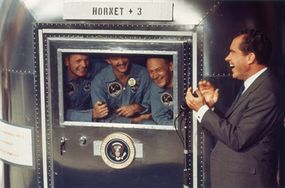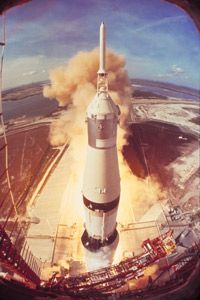The Apollo 11 Mission
Previous missions had flown by the moon, landed on it and sent back photographs of its surface. But by July 1969, NASA was ready to land men on the moon. The historic mission's crew was made up of Commander Neil Armstrong, Command Module Pilot Michael Collins and Lunar Module Pilot Edwin "Buzz" Aldrin.
This is how the mission unfolded:
Advertisement
July 16, 1969 at 9:32 a.m. EDT -- A Saturn V rocket carrying the Apollo 11 spacecraft lifted off from John F. Kennedy Space Center in Florida. It carried the Command Service Module housing the astronauts and a Lunar Module that Armstrong and Aldrin would use to land on the moon. After orbiting the Earth one-and-a-half times, the Saturn V's third stage re-fired and sent Apollo 11 rocketing toward the moon. Soon after, the Command Service Module, Columbia, separated from the Saturn, flipped around and connected nose-to-nose with the Lunar Module, Eagle. The joined spacecraft continued on its path.
July 19 -- Apollo 11 entered lunar orbit. After 24 hours in orbit and a check of the Lunar Module's switches and communication systems, Armstrong and Aldrin separated Eagle from Columbia and prepared to make their descent to the moon's surface. Collins remained in Columbia to serve as the communication link between the Lunar Module and mission control back on Earth.
July 20 -- 102 hours after launch, at 4:17 p.m. EDT, Armstrong and Aldrin landed in the Sea of Tranquility, a flat lava plain on the moon's surface. Armstrong sent this famous message to mission control: "Houston. Tranquility Base here. The Eagle has landed." Just moments after landing, the two astronauts began preparing to abort their mission immediately and return to the Command Service Module, just in case an emergency occurred. Then they powered down.
Six-and-a-half hours later, Armstrong stepped out of the spacecraft and took his first steps on the moon.
Once Aldrin joined Armstrong on the moon's surface, the pair of astronauts began collecting lunar surface material. As they worked, they noted the differences in the moon's gravity compared to Earth. Because the moon has one-sixth of Earth's gravity, the astronauts had to move by slowly loping or hopping with both feet like a kangaroo.
While on the moon, Armstrong and Aldrin created a now-famous image as they erected the American flag. This wasn't as easy as it looked. The pole went in the first 5 to 6 inches (12.7 to 15.2 centimeters) of lunar soil easily but then met with resistance. The astronauts had to lean the flag back slightly to get it to stay in the ground.
While on the moon, the two astronauts collected nearly 50 pounds (23 kilograms) of lunar material, took photos of the area near the landing site, set up equipment and pulled two core-tube samples from the moon's surface. They left behind a disc with 73 messages from countries around the world, a patch from Apollo 1, medals from Russian cosmonauts and a symbol of the U.S. eagle carrying an olive branch.

July 21-- 21 hours after their arrival, at 1:54 p.m. EDT, Armstrong and Aldrin lifted off from the moon, leaving the lower stage behind. Inside the Lunar Module, they traveled back into the moon's orbit, where they docked with the Command Service Module. The Eagle was set free.
July 24 -- Apollo 11 entered the Earth's atmosphere at a speed of 36,194 feet (11,032 meters) per second. It landed in the Pacific Ocean at 12:51 p.m.
In the next section, we'll look at profiles of the lunar landing missions.
